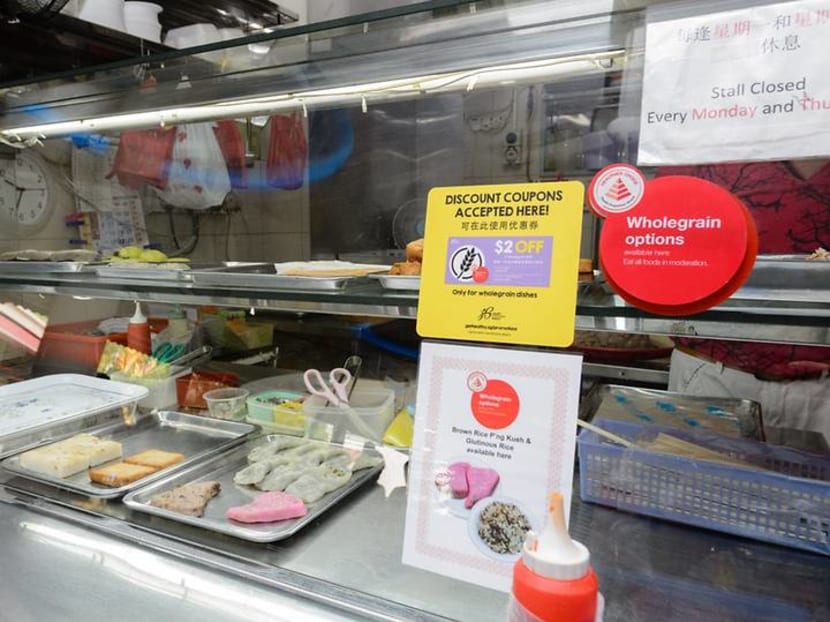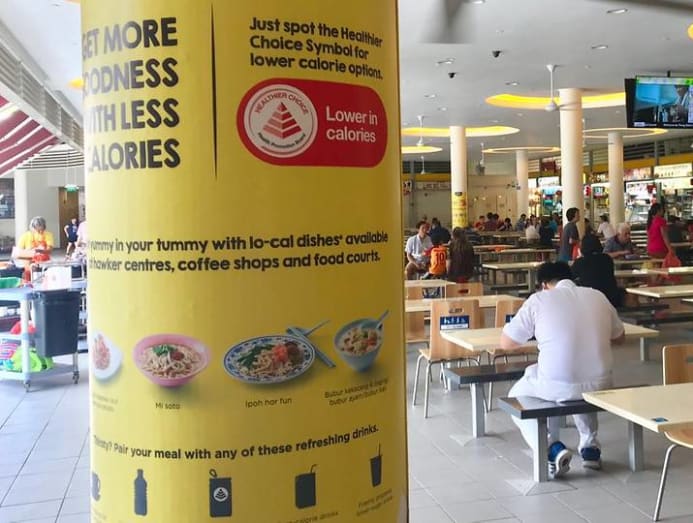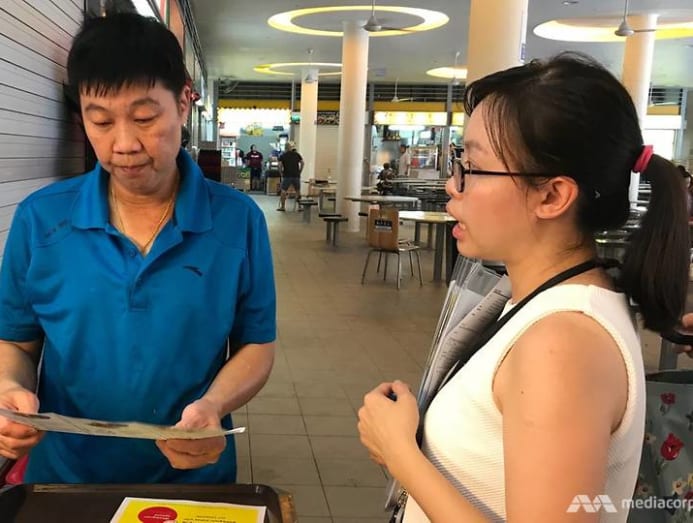Wholegrain options? Plenty of work ahead for HPB to get hawkers on board
Officers from the Health Promotion Board (HPB) have been walking the ground for months to encourage hawkers to offer wholegrain options. But there is reluctance – and hawkers say it’s largely due to customers’ demands.

Stickers at this Teochew kueh hawker stall indicate that he sells kueh made from wholegrain flour. (Photo: Health Promotion Board)
SINGAPORE: It's a late Friday morning and there is a lull in business at the Tiong Bahru Food Centre. The breakfast crowd is thinning, and the hordes of office workers that usually throng the hawker centre for lunch have yet to stream in.
It is the best time for Health Promotion Board (HPB) officer Tan Meiying to make her approach. As she wends her way through the food centre, she waves at the hawkers. Some return the greeting with a friendly smile and wave.
“Some of them are like my friends now,” she says. “They even know my child.”
She is a familiar face to the hawkers, having walked the ground there in the past few months, speaking to them to encourage them to use wholegrain staples in their dishes.
WHY DO THIS?
Ms Tan is part of a team sent out by the HPB in their ongoing efforts to make it easier for Singaporeans to choose healthier food options when they eat out.
The Healthier Dining Programme, which was introduced in 2014, started off by getting restaurants and food courts to offer healthier options such as 500-calorie meals.
In July 2017, the programme was extended to hawker centres and coffee shops, where they worked with the stallholders to offer lower-calorie options, such as reduced sugar and oil in their dishes.
To encourage take-up by consumers, the HPB runs periodic promotions such as distributing discount vouchers.

The programme is now being extended further, with the HPB working to encourage hawkers to offer healthier ingredients, such as wholegrains. To sweeten the deal for customers, promotions are lined up, such as a S$2 discount on wholegrain meals bought from participating hawkers.
By April next year, HPB aims to have 4 in 10 hawker stalls in Singapore offering low-calorie or healthier options.
HPB's deputy director of the obesity prevention management division Ann Low said that their end-goal can be summed up in two words: accessibility and availability.
“It’s not just the restaurants and food courts, but also the everyday eating places like the hawker centres and coffee shops,” she said. “So there is always a healthier option, whatever your budget is.”
But it is by no means an easy task, Ms Low explained.
“When we’re getting the hawkers to offer lower-calorie options, there’s actually a minimal change in terms of their offerings,” she said. “The hawkers get to keep their usual menu, but just use less oil or sugar.”
“But when it comes to changing of ingredients like whole grains, it will affect their operations and suppliers.”
“Some of them are really quite reluctant,” she said.
And as Ms Tan goes around encouraging hawkers to participate in the promotion, she is well aware of this reluctance.
She makes a beeline for a stall whose owner has so far refused to take part. Seeing her approach, the elderly lady grunts and waves her away.
“I’m not taking part,” the hawker said in Mandarin. “Don’t bother talking to me about it.”
DEMAND FROM CUSTOMERS IS CRUCIAL
But why are the hawkers so reluctant? A lack of customer demand appears to be the answer.
“I ordered a bit of brown rice about three months ago just to try it out,” said nasi lemak seller Tan Wah Ann. “But the customers really didn’t want it, because they think brown rice doesn’t taste as nice.”
“I cooked it already, and I couldn’t finish selling it, so I had to throw it away,” he added.
“Even if you give it to me for free, I don’t want it,” he said. “I don’t want to throw it away anymore.”
Prawn noodle seller Tan Kim Leng estimates that only about 3 to 5 per cent of customers ask for wholegrain noodles.
While most customers who try the wholegrain noodles enjoy it, he said there are many more who still believe that it will never taste as good as the regular option.
“Some of them just don’t want to accept it,” he said. “And when we’re busy, we really don’t have the time to explain to them, or promote it to them.”
Mr Tan said he is happy to offer his customers the option but admits that he orders “only a little bit” of the wholegrain noodles from his supplier.
While HPB's promotions boosted sales of his wholegrain noodles, Mr Tan admits that it will not be easy to change mindsets.
“The discounts will definitely be a boost, but I don’t think it’s long-term,” he said. “I sold up to 80 bowls a day during the promotion period. But with no promotion, I could only sell about seven to 10 bowls a day.”
BACK TO THE DRAWING BOARD
It has been a tiring few months for Ms Tan and her team. And there are times when the work can be demoralising.

“A lot of the hawkers didn’t want to talk to me at first,” she said. “They were like, who are you to come and ask me all these questions?”
“It was quite disheartening, because people looked at me like I was some weirdo.”
But her work is important: As she understands the various concerns they have, her team has been able to go back to the drawing board and tweak their various campaigns and programmes accordingly.
Through feedback from the hawkers she speaks to, she is also able to make adjustments in their approach to help persuade them to come on board. For example, after hearing from hawkers about the difficulties they faced cooking the wholegrain ingredients, she now comes armed with a brochure with detailed cooking instructions.
Wholegrain rice and noodle suppliers also sometimes join her on her walkabouts, and some of them are even prepared to offer discounts or promotions to participating hawkers who buy the ingredients.

Her efforts are starting to pay off: Currently, 13 of the 59 cooked food stalls at Tiong Bahru Food Centre offer wholegrain options regardless of whether there is a promotion or not. In the last round of promotions HPB ran in April, 30 stalls at the centre offered wholegrain options.
There are also enthusiastic hawkers who are more than willing to give it a shot, such as one kueh seller who greeted Ms Tan warmly, insisting that she sample some of the wholegrain flour kueh he has made.
“It’s hard work, but it’s fulfilling,” she said. “It’s about job satisfaction. When you see them selling the wholegrain options, you know that your hard work has paid off.”
But she admits that consumer reluctance remains the biggest challenge they face.
“We still have a lot of work to do, to increase their awareness, and break some of the myths some of them might have towards wholegrain options,” she said, explaining that the HPB is also utilising other means and channels, such as food trucks at workplaces, to get consumers to overcome their reluctance.
“They just need to try it once,” she said. “Then they’ll be more willing to have it again.”





